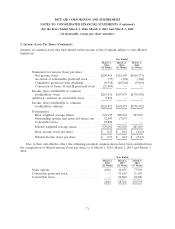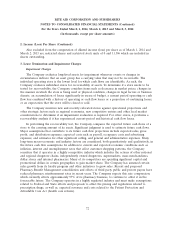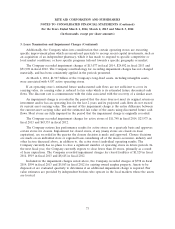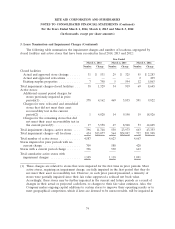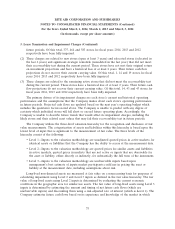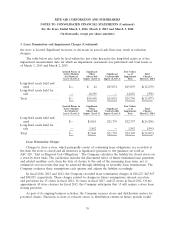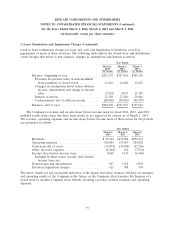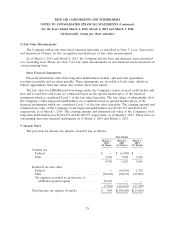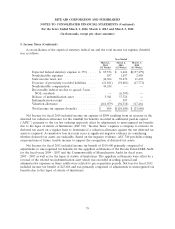Rite Aid 2014 Annual Report Download - page 82
Download and view the complete annual report
Please find page 82 of the 2014 Rite Aid annual report below. You can navigate through the pages in the report by either clicking on the pages listed below, or by using the keyword search tool below to find specific information within the annual report.RITE AID CORPORATION AND SUBSIDIARIES
NOTES TO CONSOLIDATED FINANCIAL STATEMENTS (Continued)
For the Years Ended March 1, 2014, March 2, 2013 and March 3, 2012
(In thousands, except per share amounts)
5. Income Taxes (Continued)
acquisition. Accordingly, as of March 1, 2014, March 2, 2013 and March 3, 2012, the Company had a
corresponding recoverable indemnification asset of $195, $30,710 and $156,797 from Jean Coutu
Group, included in the ‘‘Other Assets’’ line of the Consolidated Balance Sheets, to reflect the
indemnification for such liabilities.
While it is expected that the amount of unrecognized tax benefits will change in the next twelve
months, management does not expect the change to have a significant impact on the results of
operations or the financial position of the company.
The Company recognizes interest and penalties related to tax contingencies as income tax expense.
Prior to the adoption of ASC 740, ‘‘Income Taxes,’’ the Company included interest as income tax
expense and penalties as an operating expense. The Company recognized (benefit) for interest and
penalties in connection with tax matters of ($16,833), ($43,069) and ($2,113) for fiscal years 2014, 2013
and 2012, respectively. As of March 1, 2014 and March 2, 2013 the total amount of accrued income
tax-related interest and penalties was $5,364 and $22,197, respectively.
The Company files U.S. federal income tax returns as well as income tax returns in those states
where it does business. The consolidated federal income tax returns have been subject to examination
by the IRS through fiscal 2008, including the Brooks Eckerd pre-acquisition periods. However, any net
operating losses that were generated in these prior closed years may be subject to examination by the
IRS upon utilization. Tax examinations by various state taxing authorities could generally be conducted
for a period of three to five years after filing of the respective return. However, as a result of filing
amended returns, the Company has statutes open in some states from fiscal year 2005.
Net Operating Losses and Tax Credits
At March 1, 2014, the Company had federal net operating loss (NOL) carryforwards of
approximately $3,507,186. Of these, $1,906,013 will expire, if not utilized, between fiscal 2020 and 2022.
An additional $1,519,062 will expire, if not utilized, between fiscal 2028 and 2032.
At March 1, 2014, the Company had state NOL carryforwards of approximately $4,476,975, the
majority of which will expire between fiscal 2019 and 2027.
The Company’s federal and state net operating loss carryforwards include deductions of $18,365
for windfall tax benefits that have not yet been recognized in the financial statements at March 1, 2014.
These tax benefits will be credited to additional paid-in capital when they reduce current taxable
income consistent with the tax law ordering approach.
At March 1, 2014, the Company had federal business tax credit carryforwards of $50,595, the
majority of which will expire between 2019 and 2021. In addition to these credits, the Company had
alternative minimum tax credit carryforwards of $3,221.
Valuation Allowances
The valuation allowances as of March 1, 2014 and March 2, 2013 apply to the net deferred tax
assets of the Company. The Company maintained a full valuation allowance of $2,060,811 and
$2,223,675 against net deferred tax assets as a result of a three year cumulative loss at March 1, 2014
and March 2, 2013, respectively.
81


